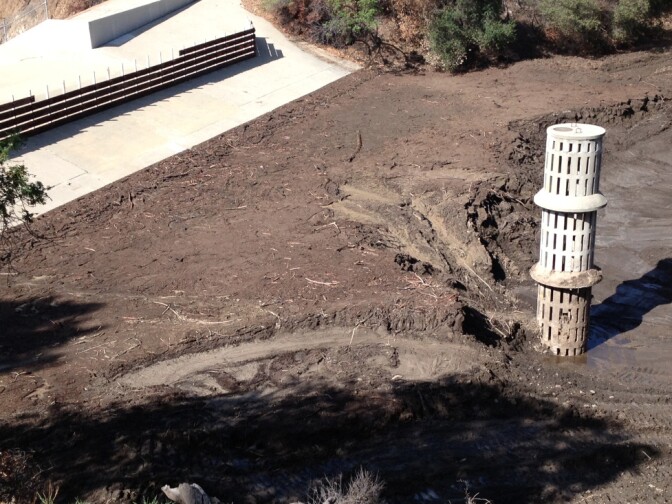With our free press under threat and federal funding for public media gone, your support matters more than ever. Help keep the LAist newsroom strong, become a monthly member or increase your support today.
LA County officials prepare to empty storm basins above Glendora
Debris basins aren't something many people think about, let alone visit. But on Saturday, Glendora residents trekked up a hill above Sierra Madre Avenue for a glimpse of two mud-filled basins with officials from L.A. County Public Works. The tour was designed to let residents see the estimated 36,000 cubic yards of debris that will be removed by county trucks in upcoming weeks.
"The residents who do see the trucks coming and going are probably asking themselves, where is it coming from, where is it going?" said Steve Sheridan, an engineer for the L.A. County Department of Public Works.
RELATED: The downside of Southern California's rain: Debris flows
The way debris basins work is that whatever flows downhill — mostly mud, but also vegetation, tree trunks, rocks — collects in them. A concrete structure allows water to flow over and downhill, and a roughly 25-foot drainage tower in the middle allows liquid to filter through the bottom, while the solid debris piles up and stays put.
"If we didn't have the debris basins in place, then the community below could be in harm's way," said Michael Miranda, a county engineer, recalling the devastation caused by a 1969 storm that hit Glendora before the basins were there. "With the debris basins in place, they are meant to protect the residents, and they really have worked quite well."
They were critical during recent heavy rains, sitting below hills stripped by January's devastating Colby Fire , which destroyed nearby homes.
"The fire was scary enough in itself, but I was really worried about exactly what we have here now, nothing on the hillsides — and rain," said Marie Mota, one of several Glendora residents who came to see what a debris basin looks like. "My husband's catch phrase is 'that is why I pay my taxes,' and this is an exact illustration of that."
On Saturday, even as bulldozers worked to clear one of the two basins, there was a good eight feet of mud piled up at the bottom.
Sheridan said the basins get so clogged after a storm that county workers have to pick their way to the towers sometimes in a small aluminum rowboat, manually picking out vegetation that's clogging the drainage towers so that the basins can drain.
Once that happens, workers separate the mud with bulldozers to further dry it out, before it's trucked to disposal sites. As for the inevitable dust, Sheridan said, there will be water trucks and sweepers to try and minimize it, although it can't be completely contained.
The final resting place for the mud is a site in Irwindale.
Longtime Glendora resident Carol Coppel snapped photos of the sweeping view from the basins afterward. She said she didn't mind the trucks or the dust — they're just part of what comes with life in the foothills.
"Well, when we have disasters like this, yeah, it's a positive, it's not a negative," Coppel said. "You are this close to the foothills, this is part of it. But it's well worth it."












